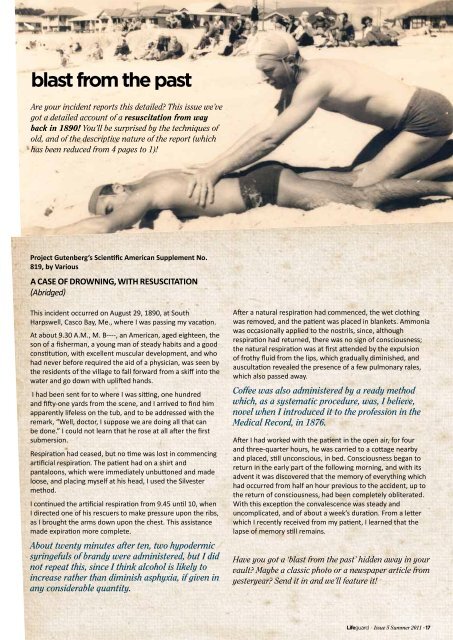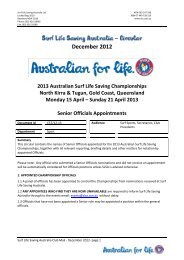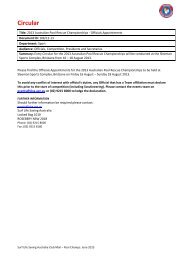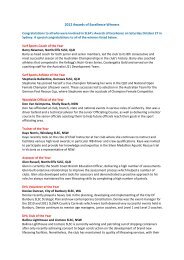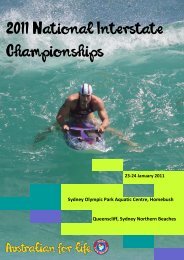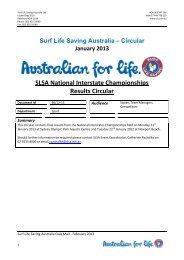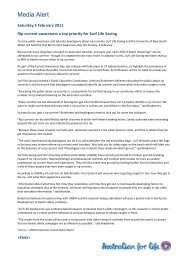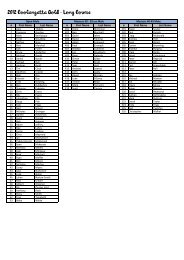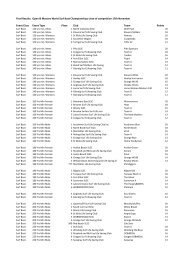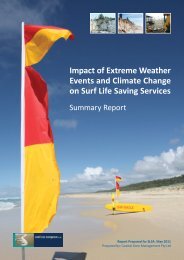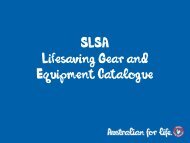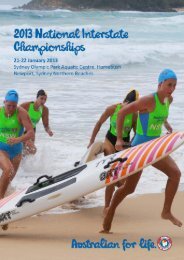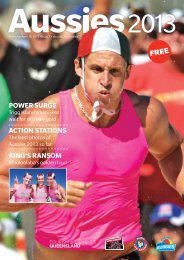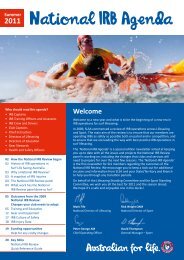Australian Lifeguard magazine - Surf Life Saving Australia
Australian Lifeguard magazine - Surf Life Saving Australia
Australian Lifeguard magazine - Surf Life Saving Australia
You also want an ePaper? Increase the reach of your titles
YUMPU automatically turns print PDFs into web optimized ePapers that Google loves.
last from the pastAre your incident reports this detailed? This issue we’vegot a detailed account of a resuscitation from wayback in 1890! You’ll be surprised by the techniques ofold, and of the descriptive nature of the report (whichhas been reduced from 4 pages to 1)!Project Gutenberg’s Scientific American Supplement No.819, by VariousA CASE OF DROWNING, WITH RESUSCItatION(Abridged)This incident occurred on August 29, 1890, at SouthHarpswell, Casco Bay, Me., where I was passing my vacation.At about 9.30 A.M., M. B----, an American, aged eighteen, theson of a fisherman, a young man of steady habits and a goodconstitution, with excellent muscular development, and whohad never before required the aid of a physician, was seen bythe residents of the village to fall forward from a skiff into thewater and go down with uplifted hands.I had been sent for to where I was sitting, one hundredand fifty-one yards from the scene, and I arrived to find himapparently lifeless on the tub, and to be addressed with theremark, “Well, doctor, I suppose we are doing all that canbe done.” I could not learn that he rose at all after the firstsubmersion.Respiration had ceased, but no time was lost in commencingartificial respiration. The patient had on a shirt andpantaloons, which were immediately unbuttoned and madeloose, and placing myself at his head, I used the Silvestermethod.I continued the artificial respiration from 9.45 until 10, whenI directed one of his rescuers to make pressure upon the ribs,as I brought the arms down upon the chest. This assistancemade expiration more complete.About twenty minutes after ten, two hypodermicsyringefuls of brandy were administered, but I didnot repeat this, since I think alcohol is likely toincrease rather than diminish asphyxia, if given inany considerable quantity.After a natural respiration had commenced, the wet clothingwas removed, and the patient was placed in blankets. Ammoniawas occasionally applied to the nostrils, since, althoughrespiration had returned, there was no sign of consciousness;the natural respiration was at first attended by the expulsionof frothy fluid from the lips, which gradually diminished, andauscultation revealed the presence of a few pulmonary rales,which also passed away.Coffee was also administered by a ready methodwhich, as a systematic procedure, was, I believe,novel when I introduced it to the profession in theMedical Record, in 1876.After I had worked with the patient in the open air, for fourand three-quarter hours, he was carried to a cottage nearbyand placed, still unconscious, in bed. Consciousness began toreturn in the early part of the following morning, and with itsadvent it was discovered that the memory of everything whichhad occurred from half an hour previous to the accident, up tothe return of consciousness, had been completely obliterated.With this exception the convalescence was steady anduncomplicated, and of about a week’s duration. From a letterwhich I recently received from my patient, I learned that thelapse of memory still remains.Have you got a ‘blast from the past’ hidden away in yourvault? Maybe a classic photo or a newspaper article fromyesteryear? Send it in and we’ll feature it!<strong><strong>Life</strong>guard</strong> · Issue 5 Summer 2011 · 17


